The Effect of Air Turbulence on Vortex Beams in Nonlinear Propagation
Abstract
1. Introduction
2. Numerical Simulation Model
3. Results and Discussion
4. Conclusions
Author Contributions
Funding
Institutional Review Board Statement
Informed Consent Statement
Data Availability Statement
Conflicts of Interest
References
- Zhang, Z.L.; Chen, Y.P.; Cui, S.; Feng, H.; Chen, M.; Zhang, Z.; Yu, J.; Chen, L.M.; Sheng, Z.M.; Zhang, J. Manipulation of polarizations for broadband terahertz waves emitted from laser plasma filaments. Nat. Photonics 2018, 12, 554–559. [Google Scholar] [CrossRef]
- Dey, I.; Jana, K.; Fedorov, V.Y.; Koulouklidis, A.D.; Mondal, A.; Shaikh, M.; Sarkar, D.; Lad, A.D.; Tzortzakis, S.; Couairon, A.; et al. Highly efficient broadband terahertz generation from ultrashort laser filamentation in liquids. Nat. Commun. 2017, 8, 1–7. [Google Scholar] [CrossRef]
- Varela, O.; Alonso, B.; Sola, I.J.; Román, S.; Zaïr, A.; Méndez, C.; Roso, L. Self-compression controlled by the chirp of the input pulse. Opt. Lett. 2010, 35, 3649–3651. [Google Scholar] [CrossRef]
- Adachi, S.; Suzuki, T. Self-compression of femtosecond deep-ultraviolet pulses by filamentation in krypton. Opt. Lett. 2017, 42, 1883–1886. [Google Scholar] [CrossRef]
- Xu, H.L.; Lötstedt, E.; Lwasaki, A.; Yamanouchi, K. Sub-10-fs population inversion in N2+ in air lasing through multiple state coupling. Nat. Commun. 2015, 6, 8347. [Google Scholar] [CrossRef]
- Yao, J.P.; Jiang, S.C.; Chu, W.; Zeng, B.; Wu, C.Y.; Lu, R.F.; Li, Z.T.; Xie, H.Q.; Li, G.H.; Wang, Z.S.; et al. Population Redistribution Among Multiple Electronic States of Molecular Nitrogen Ions in Strong Laser Fields. Phys. Rev. Lett. 2016, 116, 143007. [Google Scholar] [CrossRef]
- Xu, H.L.; Cheng, Y.; Chin, S.-L.; Sun, H.-B. Femtosecond laser ionization and fragmentation of molecules for environmental sensing. Laser Photonics Rev. 2015, 9, 275–293. [Google Scholar] [CrossRef]
- Odhner, J.; Levis, R. Optical Spectroscopy Using Gas-Phase Femtosecond Laser Filamentation. Rev. Phys. Chem. 2014, 65, 605–628. [Google Scholar] [CrossRef]
- Couairon, A.; Mysyrowicz, A. Femtosecond filamentation in transparent media. Phys. Rep. 2007, 441, 47–189. [Google Scholar] [CrossRef]
- Bergé, L.; Skupin, S.; Kasparian, J.; Wolf, J.-P. Ultrashort filaments of light in weakly ionized, optically transparent media. Rep. Prog. Phys. 2007, 70, 1633–1713. [Google Scholar] [CrossRef]
- Kasparian, J.; Wolf, J.-P. Physics and applications of atmospheric nonlinear optics and filamentation. Opt. Express 2008, 16, 466–493. [Google Scholar] [CrossRef] [PubMed]
- Béjot, P.; Kasparian, J.; Henin, S.; Loriot, V.; Vieillard, T.; Hertz, E.; Faucher, O.; Lavorel, B.; Wolf, J.-P. Higher-Order Kerr Terms Allow Ionization-Free Filamentation in Gases. Phys. Rev. Lett. 2010, 104, 103903. [Google Scholar] [CrossRef] [PubMed]
- Béjot, P.; Kasparian, J.; Lavorel, B.; Wolf, J.-P.; Faucher, O. Transition from Plasma-Driven to Kerr-Driven Laser Filamentation. Phys. Rev. Lett. 2011, 106, 243902. [Google Scholar] [CrossRef] [PubMed]
- Schimmel, G.; Produit, T.; Mongin, D.; Kasparian, J.; Wolf, J.-P. Free space laser telecommunication through fog. Optica 2018, 5, 1338–1341. [Google Scholar] [CrossRef]
- Schroeder, M.C.; Andral, U.; Wolf, J.-P. Opto-mechanical expulsion of individual micro-particles by laser-induced shockwave in air. AIP Adv. 2022, 12, 095119. [Google Scholar] [CrossRef]
- Willner, A.E.; Huang, H.; Yan, Y.; Ren, Y.; Ahmed, N.; Xie, G.; Bao, C.; Li, L.; Cao, Y.; Zhao, Z.; et al. Optical communications using orbital angular momentum beams. Adv. Opt. Photonics 2015, 7, 66–106. [Google Scholar] [CrossRef]
- Kim, H.-C.; Lee, Y.H. Hermite–Gaussian and Laguerre–Gaussian beams beyond the paraxial approximation. Opt. Commun. 1999, 169, 9–16. [Google Scholar] [CrossRef]
- Wang, A.D.; Zhu, L.; Deng, M.L.; Lu, B.; Guo, X.J. Experimental demonstration of OAM-basedtransmitter mode diversity data transmission under atmosphere turbulence. Opt. Express 2021, 29, 13171–13182. [Google Scholar] [CrossRef]
- Zhu, L.; Wang, A.D.; Deng, M.L.; Lu, B.; Guo, X.J. Free-space optical communication with quasi-ring Airy vortex beam under limited-size receiving aperture and atmospheric turbulence. Opt. Express 2021, 29, 32580–32590. [Google Scholar] [CrossRef]
- Roux, F.S.; Wellens, T.; Shatokhin, V.N. Entanglement evolution of twisted photons in strong atmospheric turbulence. Phys. Rev. A 2015, 92, 012326. [Google Scholar] [CrossRef]
- Zhang, Y.W.; Agnew, M.; Roger, T.; Roux, F.S.; Konrad, T.; Faccio, D.; Leach, J.; Forbes, A. Simultaneous entanglement swapping of multiple orbital angular momentum states of light. Nat. Commun. 2017, 8, 1–7. [Google Scholar] [CrossRef]
- Leonhard, N.D.; Shatokhin, V.N.; Buchleitner, A. Universal entanglement decay of photonic-orbital-angular-momentum qubit states in atmospheric turbulence. Phys. Rev. A 2015, 91, 012345. [Google Scholar] [CrossRef]
- Wang, J.; Yang, J.Y.; Fazal, I.M.; Ahmed, N.; Yan, Y.; Huang, H.; Ren, Y.X.; Yue, Y.; Dolinar, S.; Tur, M.; et al. Terabit free-space data transmission employing orbital angular momentum multiplexing. Nat. Photonics 2012, 6, 488–496. [Google Scholar] [CrossRef]
- Li, J.; Chen, X.; McDuffie, S.; Najjar, M.A.M.; Rafsanjani, S.M.H.; Korotkova, O. Mitigation of atmospheric turbulence with random light carrying OAM. Opt. Commun. 2019, 446, 178–185. [Google Scholar] [CrossRef]
- Ayeni, O.O.; Ojo, J.S.; Owolawi, P.A.; Ajewole, M.O. Performance comparison of diversity techniques with Addictive White Gaussian Channel (AWGC) in free space optical communication (FSO) under atmospheric turbulence scenario. Int. J. Phys. Sci. 2023, 18, 12–18. [Google Scholar] [CrossRef]
- Walsh, S.M.; Karpathakis, S.F.E.; McCann, A.S.; Dix-matthews, B.P.; Frost, A.M.; Gozzard, D.R.; Gravestock, C.T.; Schediwy, S.W. Demonstration of 100 Gbps coherent free-space optical communications at LEO tracking rates. Sci. Rep. 2022, 12, 18345. [Google Scholar] [CrossRef]
- Ebrahimi, F.; Ghassemlooy, Z.; Olyaee, S. Investigation of a hybrid OFDM-PWM/PPM visible light communications system. Opt. Commun. 2018, 429, 65–71. [Google Scholar] [CrossRef]
- Eso, E.; Ghassemlooy, Z.; Zvanovec, S.; Sathian, J.; Abadi, M.M.; Younus, O.I. Performance of Vehicular Visible Light Communications underthe Effects of Atmospheric Turbulence with Aperture Averaging. Sensors 2021, 21, 2751. [Google Scholar] [CrossRef]
- Kasparian, J.; Rodriguez, M.; Méjean, G.; Yu, J.; Salmon, E.; Wille, H.; Bourayou, R.; Frey, S.; André, Y.-B.; Mysyrowicz, A.; et al. White-Light Filaments for Atmospheric Analysis. Science 2003, 301, 61–64. [Google Scholar] [CrossRef]
- Kandidov, V.P.; Kosareva, O.G.; Tamarov, M.P.; Brodeur, A.; Chin, S.L. Nucleation and random movement of filaments in the propagation of high-power laser radiation in a turbulent atmosphere. Quantum Electron. 1999, 29, 911–915. [Google Scholar] [CrossRef]
- Peñano, J.R.; Sprangle, P.; Hafizi, B.; Ting, A.; Gordon, D.F.; Kapetanakos, C.A. Propagation of ultra-short, intense laser pulses in air. Phys. Plasmas 2004, 11, 2865–2874. [Google Scholar] [CrossRef]
- Sunilkumar, K.; Anand, N.; Moorthy, K.K.; Ilavazhagan, G. Enhanced optical pulse broadening in free-space optical links due to the radiative effects of atmospheric aerosols. Opt. Express 2021, 29, 865–876. [Google Scholar] [CrossRef]
- Chin, S.L.; Talebpour, A.; Yang, J.; Petit, S.; Kandidov, V.P.; Kosareva, O.G.; Tamarov, M.P. Filamentation of femtosecond laser pulses in turbulent air. Appl. Phys. B-Lasers Opt. 2002, 74, 67–76. [Google Scholar] [CrossRef]
- Houard, A.; Franco, M.; Prade, B.; Durécu, A.; Lombard, L.; Bourdon, P.; Vasseur, O.; Fleury, B.; Robert, C.; Michau, V.; et al. Femtosecond filamentation in turbulent air. Phys. Rev. A 2008, 78, 033804. [Google Scholar] [CrossRef]
- Gill, H.S.; Singh, M.L.; Singh, M.; Priyanka; Kaur, S.; Kaur, H. Analysis of full reference quality metrics for image transmission over a MIMO OWC channel under varying turbulent conditions. Int. J. Commun. Syst. 2023, 36, e5426. [Google Scholar]
- Naghshvarianjahromi, M.; Kumar, S.; Deen, M.J. Free Space Ground to Satellite Optical Communications Using Kramers-Kronig Transceiver in the Presence of Atmospheric Turbulence. Sensors 2022, 22, 3435. [Google Scholar] [CrossRef] [PubMed]
- Liu, W.W.; Chin, S.L. Abnormal wavelength dependence of the self-cleaning phenomenon during femtosecond-laser-pulse filamentation. Phys. Rev. A 2007, 76, 013826. [Google Scholar] [CrossRef]
- Sun, X.D.; Gao, H.; Zhang, S.W.; Liu, W.W. Numerical simulation of the generation of multiple laser filaments by an axicon array. J. Mod. Opt. 2013, 60, 1637–1643. [Google Scholar] [CrossRef]
- Talebpour, A.; Yang, J.; Chin, S.L. Semi-empirical model for the rate of tunnel ionization of N2 and O2 molecule in an intense Ti:sapphire laser pulse. Opt. Commun. 1999, 163, 29–32. [Google Scholar] [CrossRef]
- Dubietis, A.; Tamošauskas, G.; Fibich, G.; Ilan, B. Multiple filamentation induced by input-beam ellipticity. Opt. Lett. 2004, 29, 1126–1128. [Google Scholar] [CrossRef]
- Sun, X.D.; Gao, H.; Zeng, B.; Xu, S.Q.; Liu, W.W.; Cheng, Y.; Xu, Z.Z.; Mu, G.G. Multiple filamentation generated by focusing femtosecond laser with axicon. Opt. Lett. 2012, 37, 857–859. [Google Scholar] [CrossRef] [PubMed]
- Zeng, T.; Gao, H.; Sun, X.D.; Liu, W.W. Turbulence-induced beam wandering during femtosecond laser filamentation. Chin. Opt. lett. 2015, 13, 070008. [Google Scholar] [CrossRef]
- Johansson, E.M.; Gavel, D.T. Simulation of stellar speckle imaging. Proc. SPIE 1994, 2200, 372–383. [Google Scholar]
- Charnotskii, M. Comparison of four techniques for turbulent phase screens simulation. J. Opt. Soc. Am. A 2020, 37, 738–747. [Google Scholar] [CrossRef]
- Yuan, Y.S.; Lei, T.; Li, Z.H.; Li, Y.J.; Gao, S.C.; Xie, Z.W.; Yuan, X.C. Beam wander relieved orbital angular momentum communication in turbulent atmosphere using Bessel beams. Sci. Rep. 2017, 7, 2045–2322. [Google Scholar] [CrossRef]
- Polynkin, P.; Kolesik, M.; Roberts, A.; Faccio, D.; Trapani, P.D.; Moloney, J. Generation of extended plasma channels in air using femtosecond Bessel beams. Opt. Express 2008, 16, 15733–15740. [Google Scholar] [CrossRef]
- Akturk, S.; Zhou, B.; Franco, M.; Couairon, A.; Mysyrowicz, A. Generation of long plasma channels in air by focusing ultrashort laser pulses with an axicon. Opt. Commun. 2009, 282, 129–134. [Google Scholar] [CrossRef]
- Papazoglou, D.G.; Suntsov, S.; Abdollahpour, D.; Tzortzakis, S. Tunable intense Airy beams and tailored femtosecond laser filaments. Phys. Rev. A 2010, 81, 061807. [Google Scholar] [CrossRef]
- Liao, T.H.; Gao, Q. Image recovery from double amplitudes in fractional Fourier domain. Chin. Phys. 2006, 15, 347–352. [Google Scholar]
- Liu, Y.; Song, X.; Ni, X.; Qi, J.; Liu, Z. Measurement of angle-of-arrival fluctuations over a real atmospheric turbulent path. In Proceedings of the 2015 International Conference on Optoelectronics and Microelectronics, Changchun China, 16–18 July 2015. [Google Scholar]
- Frederickson, P.; Davidson, K.; Zeisse, C.; Bendall, I. A Comparison of Near-surface Bulk and Scintillation Cn2 Measure-ments during EOPACE. Proc. SPIE 1998, 3433, 77–88. [Google Scholar]








Disclaimer/Publisher’s Note: The statements, opinions and data contained in all publications are solely those of the individual author(s) and contributor(s) and not of MDPI and/or the editor(s). MDPI and/or the editor(s) disclaim responsibility for any injury to people or property resulting from any ideas, methods, instructions or products referred to in the content. |
© 2023 by the authors. Licensee MDPI, Basel, Switzerland. This article is an open access article distributed under the terms and conditions of the Creative Commons Attribution (CC BY) license (https://creativecommons.org/licenses/by/4.0/).
Share and Cite
Zhu, D.; Li, C.; Sun, X.; Liu, Y.; Zhang, Y.; Gao, H. The Effect of Air Turbulence on Vortex Beams in Nonlinear Propagation. Sensors 2023, 23, 1772. https://doi.org/10.3390/s23041772
Zhu D, Li C, Sun X, Liu Y, Zhang Y, Gao H. The Effect of Air Turbulence on Vortex Beams in Nonlinear Propagation. Sensors. 2023; 23(4):1772. https://doi.org/10.3390/s23041772
Chicago/Turabian StyleZhu, Di, Chunhua Li, Xiaodong Sun, Yali Liu, Yuqi Zhang, and Hui Gao. 2023. "The Effect of Air Turbulence on Vortex Beams in Nonlinear Propagation" Sensors 23, no. 4: 1772. https://doi.org/10.3390/s23041772
APA StyleZhu, D., Li, C., Sun, X., Liu, Y., Zhang, Y., & Gao, H. (2023). The Effect of Air Turbulence on Vortex Beams in Nonlinear Propagation. Sensors, 23(4), 1772. https://doi.org/10.3390/s23041772






